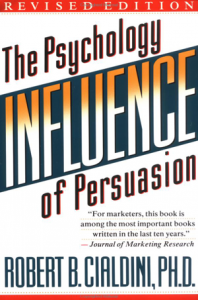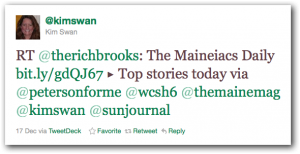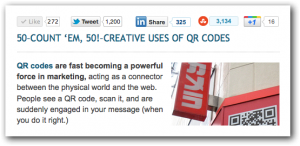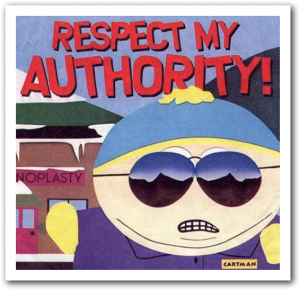 Unlock the secrets of influence and improve the effectiveness of your web marketing and social media efforts.
Unlock the secrets of influence and improve the effectiveness of your web marketing and social media efforts.
Robert Cialdini's Influence: The Psychology of Persuasion starts off with the story of a gift store owner at a tourist destination trying to sell some turquoise jewelry. It's of good quality and she's offering a fair price, but no one's buying.
She tries putting it on sale. No dice.
She moves it to the center of the store. No dice.
She has her sales force push the jewelry. Still, no dice.
In frustration, as she's leaving for a show, she scrawls a note for her store manager to sell all the jewelry at half-off. When she returns, she's amazed that it all sold, every last piece.
What's even more amazing is that her manager misread the handwritten note as DOUBLE the price, which she did.
At the higher price, the jewelry immediately sold out. Why?
The secret lies in the fact that we use shortcuts to help us get through our day. It's the only way we can manage the complexity of modern life.
One shortcut is that–in general–you get what you pay for. It's a lesson we learn early on, and is reinforced throughout our life. The tourists didn't have time to research turquoise jewelry, so once they saw the high prices, their internal tape went whrrrrr…click! and started playing the “you get what you pay for” tape. Suddenly, the jewelry was much more desirable.
In Influence, Cialdini identifies six “weapons of influence”:
- reciprocity,
- commitment and consistency,
- social proof,
- liking,
- authority, and
- scarcity.
He has amazing examples of how these each work, how “influence agents” manipulate us, and how we can prevent these weapons from working against us.
As marketers, we can use these weapons of influence for good…or for evil. In the next several posts I'm going to look at each one of these “weapons” and provide examples of how you can use them to improve the results of your web marketing and social media activity.
In the meantime, I strongly recommend picking up a copy of Influence, as the following posts just skim the surface of this amazing book. Even if you're not into marketing, Cialdini ends each chapter with ideas on how you can defend against these weapons of influence when they're used against you. That alone is worth the price of admission.
Reciprocity
 As humans, we are hard-wired to reciprocate a favor. By building favors into your online marketing you can ethically grow your business.
As humans, we are hard-wired to reciprocate a favor. By building favors into your online marketing you can ethically grow your business.
One of the major tenets of influence, according to Robert Cialdini's Influence: The Psychology of Persuasion, is reciprocity. Cialdini says:
“We are trained from childhood to chafe, emotionally, under the saddle of obligation. For this reason alone, then, we may be willing to agree to perform a larger favor than we received, merely to relieve ourselves of the psychological burden of debt.”
This is why Hare Krishnas give flowers to travelers at airports before asking for money; they know it's difficult for people to receive a gift–no matter how small–and then refuse to give a donation.
In another example, the Disabled American Veterans organization sent a donation request mailing that got a respectable 18% response rate. They did another mailing and included those self-adhesive address labels and nearly doubled their response rate to 35%!
These are interesting examples of human behavior, but how can you use them to market your business? (And to do it ethically!)
If people are likely to return or repay a favor, then you should figure out how to create favors. Here are some examples:
- Recommend people on LinkedIn before being asked: I used this for a while before I realized I was leveraging reciprocation. I would recommend someone and four out of five times the person would immediately write a recommendation for me. While that wasn't my goal, it certainly was a nice outcome.
- Create a Paper.li Daily Paper based on a Twitter list you create: This will give others free promotion to your list, and they'll get a Twitter mention every time they're featured. I get thanks and RTs almost every day from a couple of papers I created. I hated to break it to people that the list is created automatically, so I stopped! Plus, the fact that the tweet is automatically created doesn't diminish the point that I found these people and added them to a list I keep on Twitter.
- Interview people for your blog or video: Ask people you respect to be interviewed for your blog or video. This is especially effective if you have a blog with good reach, or if you can blog for an organization with a wide reach. (I have the pleasure of being able to blog for both FastCompany.com and Social Media Examiner.) Make it easy on them by asking if they want to be interviewed via phone, in person, or by email. (Email allows them to craft their answer and appear much smarter and clever than they actually are…which is why it's my personal favorite.)
- Offer advertising space on your blog for free: Whether it was unused or not, you can generate a lot of good will by offering advertising space to your customers, prospects, or local non-profits.
- Put on free, educational webinars: By creating free webinars that help your ideal customer, you have created some obligation. You can then follow up a 45-minute, content-rich presentation with an offer or request. You'll have much better success than just asking for the sale right away.
Again, you can use these techniques for good or evil. Part of what I love about living in Maine is that it's a “small town.” What comes around, goes around. The same is true on social media.
If people feel you are manipulating their behavior, you may end up destroying your reputation and your business. (Cialdini shares some examples in his book.)
Instead, just be aware of our human need to repay favors, and use them to improve your web marketing and social media networking techniques.
Have you ever knowingly or unknowingly used the power of reciprocity in your own marketing? Or do you have some ideas on what you might do differently, now that you're aware of reciprocity?
Commitment & Consistency
People are hard-wired to be consistent, especially when they've publicly committed to a belief. How does that impact your web marketing & social media?
In chapter 2 of Robert Cialdini's masterful Influence: The Psychology of Persuasion, we learned that people have a knee-jerk reaction to responding in kind (or better) to favors…a trait referred to as reciprocity. Now, in the next chapter, we learn that we also wish to be seen as consistent.
Cialdini has a wealth of examples of this in his chapter, but one example that stuck with me is the story of people who agreed to put a giant, ugly sign on their front lawn, in front of their gorgeous home, that said Drive Safely. Not surprisingly, only 17% agreed.
However, in another group, they got an astounding 76% to agree to the same ugly signs! What was the difference?
Two weeks previous, they had asked this second group of homeowners if they would put a small, inconspicuous window sticker about safe driving in their window. That's all it took. These people then saw themselves as people who were serious about safe driving, so putting a gawd-awful sign that destroyed their property value was in keeping with their ideals.
In other words, they were being consistent.
There are examples from POW camps to hazing to getting people to write short essays on why they love brand X throughout the chapter, and how by getting people to make small commitments, (window sticker) you can move them to see themselves in a new light, and then take actions that are consistent with that new belief.
As is the case with all of these chapters, the techniques can be used for good or ill…that's up to you. But if you make a commitment in the comments section below that you are an ethical marketer and will only use these for good, I think we'll all sleep better at night.
So, how can you use Commitment and Consistency to improve your web marketing and social media techniques?
Here are some examples:
- Run a Facebook contest where entrants write why they love/use your product or brand. The best answer will win the contest, but meanwhile, so many more people have publicly committed their loyalty to your brand, so now they see themselves as your evangelist. Just make sure that you use a 3rd party approved contest provider at Facebook, or the whole contest could backfire.
- Run a similar contest on Twitter. In 140 characters or less, get people to say why they use your brand using your handle and/or a special hashtag.
- Get a prospect to make a small yes, like download a whitepaper or sample. If leads them to see themselves as a customer, you can follow up with an immediate, bigger ask. I.e., they download an article, and on the landing page (or at the end of the article) you then say, “Since you’re obviously such a dog lover/fitness buff/savvy marketer, you’ll want to join our exclusive club/buy this Quick Start Guide, etc.
Are there any (ethical) methods that you can think of that would tap into our need to be consistent to build your own business? Let us know in the comments section.
Social Proof
 When we are uncertain of how to behave or react, we look to others to guide our reaction. This is a powerful tool for web marketing and social media.
When we are uncertain of how to behave or react, we look to others to guide our reaction. This is a powerful tool for web marketing and social media.
The first two tenets of Robert Cialdini's Influence: The Psychology of Persuasion, are reciprocation and commitment & consistency…two items that are hard-wired into us. The next tenet is all about external forces: Social Proof.
From laugh tracks to tip jars, we are influenced by the actions and reactions of others. This is especially true when we're unsure of how to behave in a given situation.
In Cialdini's chapter on social proof he includes a number of examples of social proof gone haywire, from Jonestown to the murder of Catherine Genovese and the lack of action or reaction from 38 witnesses.
There are a number of variables that impact social proof's influence over us.
One is how much we are like the other people we are witnessing. In one story, Cialdini's son wouldn't give up his “floaties” until he saw another three-year-old swimming without one. This after multiple lessons from his dad and a 6'2″ swimming coach. Once he saw his friend without floaties in the water he knew a three-year-old could do it.
Another variable is how many people make up the social proof: “The greater the number of people who find any idea correct, the more the idea will be correct.”
You can easily demonstrate social proof yourself. Just get a few people in a crowd to start looking to the sky. It won't be long before the entire crowd is looking up.
So how can you use social proof in your web marketing and social media?
If social proof seems like an obvious fit for social media, you're right. In fact, so much of social media marketing is based on social proof. Here are some suggestions to get you started on using social proof in your web marketing and social media:
- Seed your share buttons on your blog posts. You should always start by liking, retweeting, and otherwise sharing your blog posts with any sharing buttons you put on the top of your blog posts. Get co-workers and friends to do the same. This isn't any different than the bar tender who drops a few singles in his tip jar before his shift starts or the always annoying laugh track. (Interestingly enough, Cialdini rails against bartenders who “seed” their tip jars with bills. Having tended bar in college I'm going to have to disagree with him on this one.)
- Encourage likes, comments and video responses on YouTube. Like many social media platforms, YouTube has an algorithm that looks at social proof. To encourage this, ask for likes, comments and even video responses by including a verbal call-to-action within your video, and do the same using annotations.
- Use testimonials from “typical” customers. Add text and video customer testimonials, especially from a customer group that you're targeting. When people see people “like” them, they're more likely to respond.
Do you have any examples of how you can use social proof in your web marketing and social media? Please share them in the comments below. People just like you are adding comments on posts like these, and you want to be like them, don't you?
Liking
We like to do business with people we like. So, how does that impact your web marketing and social media activities?
In Robert Cialdini's book Influence: The Psychology of Persuasion, he talks about the tenets of influence. So far we've seen reciprocity, commitment & consistency, and social proof in action, and now we move on to liking.
It's no surprise that we're influenced by people we like…what's surprising is the degree to which we're influenced by people we like, or even those who leverage the names of people or things we like. (This is why the Tupperware party is so powerful, and why organizations send our kids' friends to sell us candles and popcorn buckets we don't need.)
We can see this at work on some of our favorite social media platforms, such as Facebook, Twitter and LinkedIn, that “suggest” that we might like a number of other people on the network, thus strengthening the network and lessening the chances that we'll leave. The social ads on Facebook are similar, when they show a product and let us know a friend “likes” it.
There's a number of things that impact our liking of a person or brand:
- Physical attractiveness: You want to think you're above such things, but you're not. Study after study proves how susceptible we are to the physical attractiveness of people, even when we don't realize we are.
- Similarity: In one study, marchers in a anti-war demonstration were more likely to sign a petition by a like-dressed person…even without reading the petition!
- Compliments: It’s amazing what we’ll do when someone says “I like you” in word or deed. Studies show it doesn’t even matter if the compliments are true. (But seriously, your hair does look great today.)
- Contact and cooperation: Studies have shown that the more we see a face, the more likely we are to believe what comes out of it is true!
- Conditioning and association: This is why we hate the weatherman and why we blame the messenger. The flip side of this is associating our offering with something positive. When an attractive model was shown next to a new car, men were more likely to rate the car as faster, better built and more expensive. None of them believed this when it was brought to their attention. (Men…right?) This could explain some of the “green washing” that’s currently going on right now as brands want to be seen as green.
So how do you use this in your own web marketing and social media?
Unfortunately, most of you just aren't as physically attractive as I am. However, eating right, exercising and wearing flattering clothes can help. Comb overs are a definite no-no.
Here are some ideas on how you can improve and bank on your own likeability:
- Be attractive. OK, maybe being physically attractive is mostly in your genes, but on the Internet no one needs to know you're a dog. That didn't actually come out the way I meant. I mean, a smiling profile pic can go a long way. Also, confidence (not to be confused with arrogance) is an attractive feature. A positive attitude can help, too. Studies show that positive tweets get shared a lot more than negative ones.
- Act similar to your customers. I'm not talking about being a fake, but I am suggesting that you use the same language that they do. This is especially true as you write articles and blog posts; you need to be talking about the same things they are, and using the same words they do so they'll find you when they do a search at Google.
- Be complimentary. Again, don't fake it. But you can certainly find positive things to say about people through social media, directly in emails, and through other venues. We all know that guy who makes snide remarks and is always trying to cut people down. It didn't work for him, did it?
- Be everywhere. Or at least appear to be everywhere. I've heard time and time again that people always see me on LinkedIn. In actuality, I only spend a few minutes a week at LinkedIn, but I subscribe to the daily email digest of relevant groups, and join in the conversation when I have something to add. I've talked to many other social media marketers who always seem to be on Twitter, but are only on there 15 minutes a day in short bursts.
- Associate your brand with popular topics. Create blog posts that tie into current or past pop culture icons that have positive associations for your customers. 10 Things I Learned About Self-Esteem from Miss Piggy or The Amazing Spider-Man Guide to Responsible Word Power.
Do you have any examples of how you've used liking in any of your web marketing or social media campaigns? Did it work?
Authority
 People are trained to follow authority figures. How can you establish your authority in your web marketing and social media activity?
People are trained to follow authority figures. How can you establish your authority in your web marketing and social media activity?
We've discussed the power of reciprocity, commitment, social proof and liking in Robert Cialdini's Influence: The Psychology of Persuasion, so far. Now it's time to look at the power that authority holds over us.
Like social proof, authority gives us a short cut in dealing with the complexity of the modern world. We listen to our doctors about health care issues, professors about scholarly matters, and talking heads on TV for everything from child-rearing to national security issues.
Often, this is a good thing. People often become authorities after years of rigorous study. However, in a famous experiment by Stanley Milgram, average people were persuaded to shock another person to near death by a person wielding nothing more than a clipboard and a white lab jacket. (Thankfully, there was no electricity and the person being “shocked” was a confidant.)
Experiment after experiment showed that humans are completely unaware of the amount of autonomy they give over to others, just because of a title, clothing, or trappings.
Let's keep in mind here, that our goal is to become effective, ethical web marketers. To that end, we need to establish our authority, not fake it.
Here are some techniques you can use to establish authority and improve the results of your online marketing:
- Establish your authority…via blogs, video, etc. Not only will people see your expertise (even if you don't hold an M.D. or other degree), members of the media will find your blog or video and interview you as an expert on the subject. The number of times I've been described as an expert because I wrote one blog post on the subject is astounding. Blog posts have gotten me interviews in both Inc. magazine and CNN.com.
- Use an authority figure. Not an authority (yet) yourself? It's easy to find someone who is and leverage their authority. A vitamin maker could interview a doctor on the benefits of the vitamin. A maker of dog products could use a dog trainer to pitch her wares.
- Leverage authority from other sources. How many blogs and websites promote the fact they were featured on Oprah, or NPR, or FastCompany.com?
- Brand yourself. In today's world, you don't need a formal title to establish expertise and authority. Just ask The Ezine Queen, The Dog Whisperer, or The Diet Ninja.
- Create virtual trappings. It's been said that visitors to our website make a decision about is in just a few seconds. A generic template isn't going to cut it. Invest in a custom design, logo, and photography.
Perhaps the best place to establish your authority is by adding intelligent comments to a well-respected blog…like this one. Go ahead and share an example of how you have used authority in your online marketing…or an example you've seen.
In my fifteen years as a web marketing authority, I've seen the value of a well-constructed comment on an industry blog, so get commenting. Don't make me take out my clipboard.
Scarcity
 Things that are scarce are perceived as more valuable than things that are plentiful. How can you use this to improve your web marketing and social media?
Things that are scarce are perceived as more valuable than things that are plentiful. How can you use this to improve your web marketing and social media?
In the final tenet of Robert Cialdini's Influence: The Psychology of Persuasion, he examines scarcity.
Like reciprocity, commitment & consistency, social proof, liking and authority before it, scarcity has an undue influence on us due to our desire for shortcuts.
We have been trained that things that are rarer have more value than things that are common. Therefore, to make things appear to have more value, marketers can promote or even fake the scarcity of an object or information.
Like many people, I subscribe to a number of daily deals, like LivingSocial. I know that if I don't act now, I'll miss out on 50% off a massage, food or snow tires. Interestingly, I've noticed I'm less compelled to buy a daily deal these days because I know that if I miss this half-off yoga class, there will be another one from a competing studio next week. The deal is still a good one, but the scarcity has been removed.
Scarcity also plays on our fear of loss. In one example from the book, homeowners who were told how much they would lose by not insulating their house bought at a much higher rate than another group that was told how much they would save.
We also hate to lose our freedom; when an object becomes scarce or won't be available much longer, we don't want to lose our freedom of choice, so we find the object more desirable. In one study, people who tasted a cookie from a jar with only two cookies found the cookie more delicious than an identical cookie in a nearly full jar.
What I found even more interesting was a sales experiment for a beef company. The first group of customers were given the standard sales pitch. The second group heard the sales pitch plus were told that there would soon be a beef shortage, and not all orders would be filled. The third group heard what the second group heard, but they were also told that this information was secret, and most people didn't know about the upcoming shortage.
The evidence was clear, as the second group bought more beef than the first group, but the third group bought even more. Scarcity of product combined with a scarcity of information proved an overwhelming sales tool.
So, how can you use scarcity to improve your web marketing and social media activity?
Scarcity works well in all types of marketing and sales, but here are a few ways you can use it yourself:
- Create a member-only group. Provide these members with information only available to them and sell membership at a premium.
- Limit seats. Limit the number of seats for your next webinar or seminar.
- Use early bird discounts. Offer discounts for people who purchase before an upcoming date. Announce this when tickets first go on sale, and then again as the deadline approaches. An alternative approach is to off a certain number of discounted seats and once those are gone, they're gone for good.
- Give special offers to a small mailing list. Start by giving people on your internal list a special opportunity to buy early, before you announce it to everyone.
Scarcity is a powerful motivator. Do you have any other ideas on how to use scarcity in your web marketing? If so, please leave a comment below. But please hurry…comments will only be open for one week, then they'll be closed forever!

